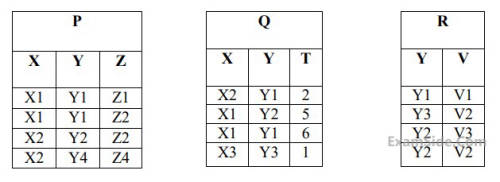1
GATE CSE 2019
Numerical
+2
-0
Consider the following relations P(X,Y,Z), Q(X,Y,T) and R(Y,V).

How many tuples will be returned by the following relational algebra query?


How many tuples will be returned by the following relational algebra query?

Your input ____
2
GATE CSE 2018
MCQ (Single Correct Answer)
+2
-0.6
Consider the relations $$r(A, B)$$ and $$s(B, C),$$ where $$s.B$$ is a primary key and $$r.B$$ is a foreign key referencing $$s.B.$$ Consider the query
$$Q:$$ $$\,\,\,\,\,\,\,\,\,$$ $$r$$ $$\,\,\,\,$$ $$\bowtie$$ $$\,\,\,\,$$ $$\left( {{\sigma _{b < 5}}\left( s \right)} \right)$$
Let $$LOJ$$ denote the natural left outer-join operation. Assume that $$r$$ and $$s$$ contain no null values.
Which one of the following queries is NOT equivalent to $$Q$$?
3
GATE CSE 2015 Set 2
MCQ (Single Correct Answer)
+2
-0.6
Consider two relations $${R_1}\left( {A,B} \right)$$ with the tuples $$(1,5), (3,7)$$ and $${R_2}\left( {A,C} \right) = \left( {1,7} \right),\left( {4,9} \right).$$
Assume that $$R(A,B,C)$$ is the full natural outer join of $${R_1}$$ and $${R_2}$$. Consider the following tuples of the form $$(A,B,C): a = (1,5,null),$$ $$b = (1,null,7),$$ $$c = (3, null, 9),$$ $$d = (4,7,null),$$ $$e = (1,5,7),$$ $$f = (3,7,null),$$ $$g = (4,null,9).$$ Which one of the following statements is correct?
Assume that $$R(A,B,C)$$ is the full natural outer join of $${R_1}$$ and $${R_2}$$. Consider the following tuples of the form $$(A,B,C): a = (1,5,null),$$ $$b = (1,null,7),$$ $$c = (3, null, 9),$$ $$d = (4,7,null),$$ $$e = (1,5,7),$$ $$f = (3,7,null),$$ $$g = (4,null,9).$$ Which one of the following statements is correct?
4
GATE CSE 2014 Set 3
MCQ (Single Correct Answer)
+2
-0.6
Consider the relational schema given below, where eId of the relation dependent is a foreign key referring to empId of the relation employee. Assume that every employee has at least one associated dependent in the dependent relation:
employee (empId, empName, empAge)
dependent (depId, eId, depName, depAge)
Consider the following relational algebra query: $$\Pi_{empId}\:(employee) - \Pi_{empId}\:(employee \bowtie_{(empId=eID) \wedge (empAge \leq depAge)} dependent)$$The above query evaluates to the set of empIds of employees whose age is greater than that of
Questions Asked from Relational Algebra (Marks 2)
Number in Brackets after Paper Indicates No. of Questions
GATE CSE 2025 Set 1 (1)
GATE CSE 2024 Set 2 (1)
GATE CSE 2019 (1)
GATE CSE 2018 (1)
GATE CSE 2015 Set 2 (1)
GATE CSE 2014 Set 3 (1)
GATE CSE 2014 Set 2 (1)
GATE CSE 2012 (3)
GATE CSE 2011 (1)
GATE CSE 2010 (1)
GATE CSE 2008 (1)
GATE CSE 2007 (4)
GATE CSE 2005 (1)
GATE CSE 2004 (1)
GATE CSE 2001 (1)
GATE CSE 1998 (1)
GATE CSE 1996 (1)
GATE CSE Subjects
Theory of Computation
Operating Systems
Algorithms
Database Management System
Data Structures
Computer Networks
Software Engineering
Compiler Design
Web Technologies
General Aptitude
Discrete Mathematics
Programming Languages